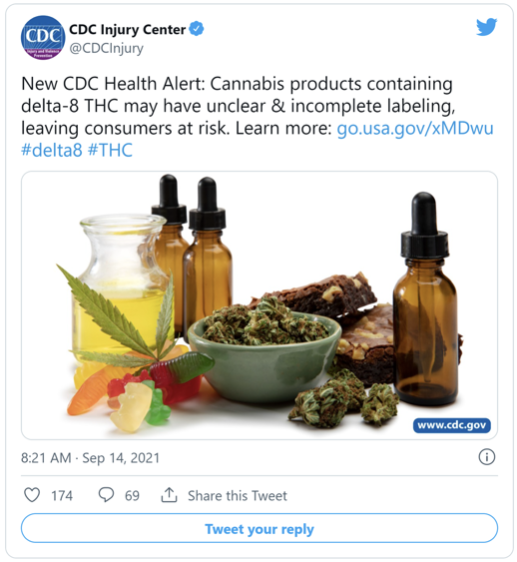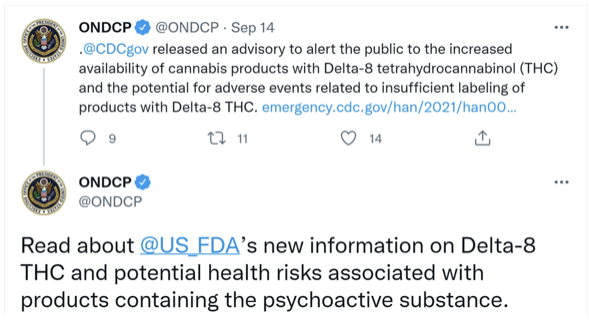FDA and CDC issue advisories re solution chemistry-derived ∆8-THC
Federal surveillance and adverse event monitoring infrastructure will chill ∆8-THC production using current state-of-the-art solution chemistry conversion process.
On September 14, 2021, the CDC issued its first Health Advisory, and the FDA published its first Consumer Update, regarding ∆8-THC. The federal health agencies were responding to a recent uptick in reported adverse events – with more than 100 people hospitalized in 2021 – related to consumption of ∆8-THC.

The CDC’s Health Advisory focused on the increasing availability of ∆8-THC products, and on the related rise in reported adverse events. It was aimed at “public health departments, healthcare professionals, first responders, poison control centers, laboratories, and the public.” Notably, the warnings did not elaborate on product names connected to any hospitalizations.
Paul Armentano, deputy director of NORML, told Marijuana Moment that the rise of delta-8 THC is a result of marijuana policy conflicts that have left gaps in access to traditional cannabis products.
“We share some of these agencies’ concerns regarding the unregulated nature of these grey-market products. Of course, the artificial market demand for these products is largely an outgrowth of marijuana prohibition,” he said. “Were whole-plant cannabis available legally, consumers would have little to no interest in experimenting with these unregulated imitations. But, absent widespread regulated access to cannabis, these unregulated producers and distributers are all too happy to fill this void.”
- ∆8-THC is available outside licensed channels in non-medical/adult use states.
“The rise in ∆8-THC products in marijuana and hemp marketplaces has increased the availability of psychoactive cannabis products, even in states … where non-medical adult cannabis use is not permitted under law.” - The chemical process to convert CBD to ∆8-THC could yield contaminated product.
“The rise in ∆8-THC products in marijuana and hemp marketplaces has increased the availability of psychoactive cannabis products, even in states, territories, and tribal nations where non-medical adult cannabis use is not permitted under law. Variations in product content, manufacturing practices, labeling, and potential misunderstanding of the psychoactive properties of ∆8-THC may lead to unexpected effects among consumers.” - Neither agency proposed banning the production or sale of the cannabinoid.
“Retailers selling cannabis products should report total THC content on product labeling, including ingredients like ∆8-THC.” - States are also aware of the increased consumer interest in ∆8-THC.
“States are taking steps to regulate or ban the cannabinoid. In Kentucky, for example, the state agriculture department banned the distribution of ∆8-THC, while Michigan put its Marijuana Regulatory Agency in control of the product and set an age limit of 21 for its use.” - CBD can be converted into ∆8-THC, ∆9-THC, and other THC isomers.
“[A] solvent, acid, and heat [are used ]to produce higher concentrations of ∆8-THC than those found naturally in the cannabis plant. This conversion process, used to produce some marketed products, may create harmful by-products that presently are not well-characterized. - ∆8-THC products are increasingly appearing in both marijuana and hemp marketplaces, some of which operate legally under state, territorial, or tribal laws.
“Most states and territories permit full or restricted hemp marketplaces that sell hemp and hemp-derived CBD products. Products sold as concentrated ∆8-THC are also available online…the sale of ∆8-THC products is not limited to regulated marijuana dispensaries in states, territories, or tribal nations where marketplaces operate under law. Rather, ∆8-THC products are sold by a wide range of businesses that sell hemp.” - A wide variety of ∆8-THC -containing products have entered the marketplace.
“Including, but not limited to, vapes, smokable hemp sprayed with ∆8-THC extract, distillates, tinctures, gummies, chocolates, and infused beverages. In addition, because testing methods for products like synthetically derived ∆8-THC are still being developed, ∆8-THC products may not be tested systematically for contaminants such as heavy metals, solvents, or pesticides that may have adverse health effects.” - The American Association of Poison Control Centers began to code ∆8-THC -specific adverse events in 2021.
“Of which there were 660 between January and July. Of these, 18% involved hospitalization, 39% involved individuals under the age of 18, and 73% took place in ‘primarily…Southern states that have not passed state laws to allow non-medical adult cannabis use. The CDC notes that the first delta-8-related adverse events likely took place last September.”

-
The FDA warned that ∆8-THC “may have potentially harmful by-products (contaminants) due to the chemicals used in the process,” and listed 5 key facts to know about ∆8-THC:
- ∆8-THC products have not been evaluated or approved by the FDA for safe use and may be marketed in ways that put the public health at risk.
“∆8-THC products currently being sold online and in stores…have not been evaluated or approved by the FDA for safe use in any context…[C]oncerns include variability in product formulations and product labeling, other cannabinoid and terpene content, and variable ∆8-THC concentrations.” - The FDA has received Adverse Event Reports involving ∆8-THC containing products.
“From December 2020 through July 2021, the FDA received ADRs from both consumers and law enforcement describing 22 patients who consumed ∆8-THC products; of these, 14 presented to a hospital or emergency room for treatment following the ingestion. Of the 22 patients, 19 experienced adverse events after ingesting ∆8-THC -containing food products (e.g., brownies, gummies). National poison control centers received 661 exposure cases of 39% involved pediatric patients less than 18 years of age products between January 2018 and July 31, 2021, 660 of which occurred between January 1, 2021, and July 31, 2021. Of the 661 exposure cases: 41% involved unintentional exposure to ∆8-THC and 77% of these unintentional exposures affected pediatric patients less than 18 years of age, 18% required hospitalizations, including children who required intensive care unit (ICU) admission following exposure to these products.” - ∆8-THC has psychoactive and intoxicating effects.
“The FDA is aware of media reports of delta-8 THC products getting consumers ‘high.’ The FDA is also concerned that delta-8 THC products likely expose consumers to much higher levels of the substance than are naturally occurring in hemp cannabis raw extracts. - ∆8-THC products often involve use of potentially harmful chemicals to create the concentrations of ∆8-THC claimed in the marketplace.
“The natural amount of ∆8-THC in hemp is very low; additional chemicals are needed to convert cannabinoids like CBD, into ∆8-THC…[M]anufacturers may use potentially unsafe household chemicals to make ∆8-THC through this chemical synthesis process. Additional chemicals may be used to change the color of the final product. The final ∆8-THC product may have potentially harmful by-products (contaminants) due to the chemicals used in the process, and there is uncertainty with respect to other potential contaminants that may be present or produced depending on the composition of the starting raw material…Manufacturing of delta-8 THC products may occur in uncontrolled or unsanitary settings, which may lead to the presence of unsafe contaminants or other potentially harmful substances.” - ∆8-THC products should be kept out of the reach of children and pets.
“These products may be purchased online, as well as at a variety of retailers, including convenience stores and gas stations, where there may not be age limits on who can purchase these products…[T]here have been numerous poison control center alerts involving pediatric patients…[A]nimal poison control centers have indicated a sharp overall increase in accidental exposure of pets to these products.”
- ∆8-THC products have not been evaluated or approved by the FDA for safe use and may be marketed in ways that put the public health at risk.
Takeaways
Safety of production methods and ∆8-THC has been surveilled nationally since January 2021
As ∆8-THC grows in popularity, the safety of solution chemistry processes and resulting ∆8-THC will come under growing scrutiny
The regulations and testing/surveillance infrastructure for ∆8-THC is being put in place at the federal level, setting the stage for validation of production methods and ∆8-THC
∆8-THC produced through solution chemistry methods will be replaced by safe ∆8-THC produced through cGMP certifiable catalysis chemistry methods